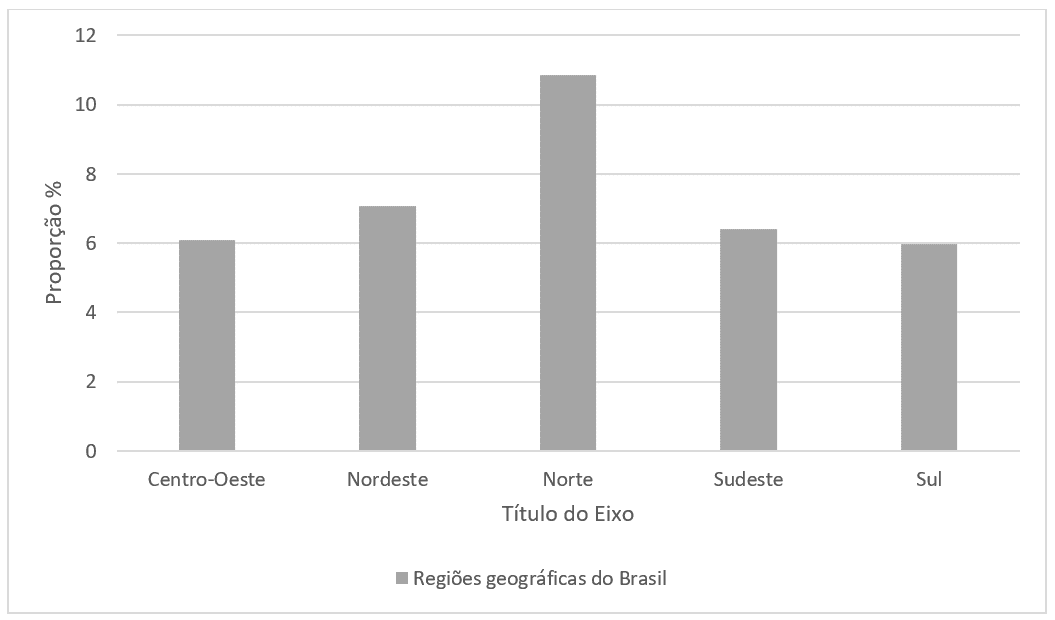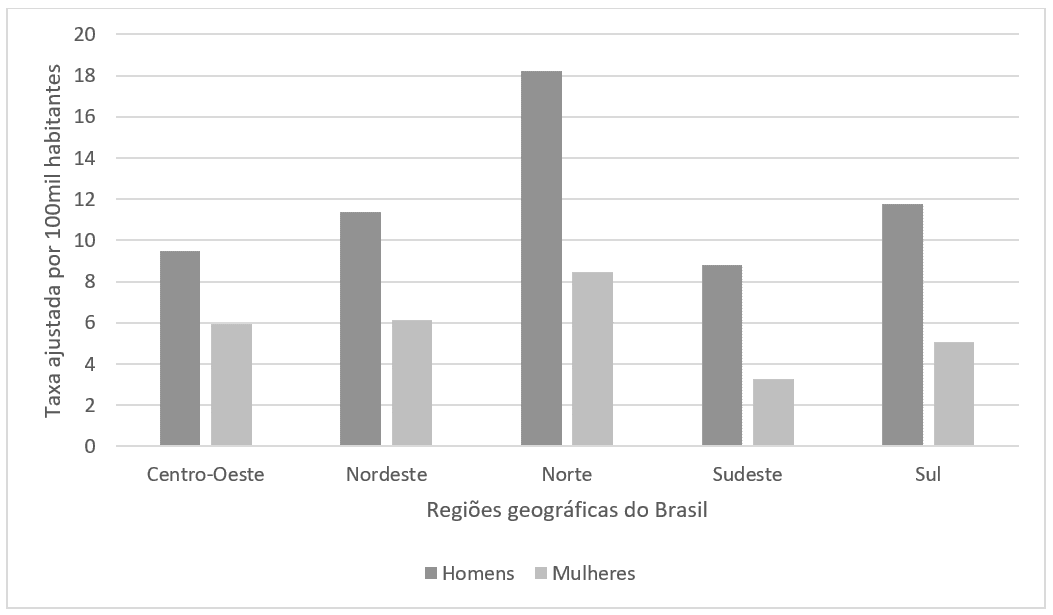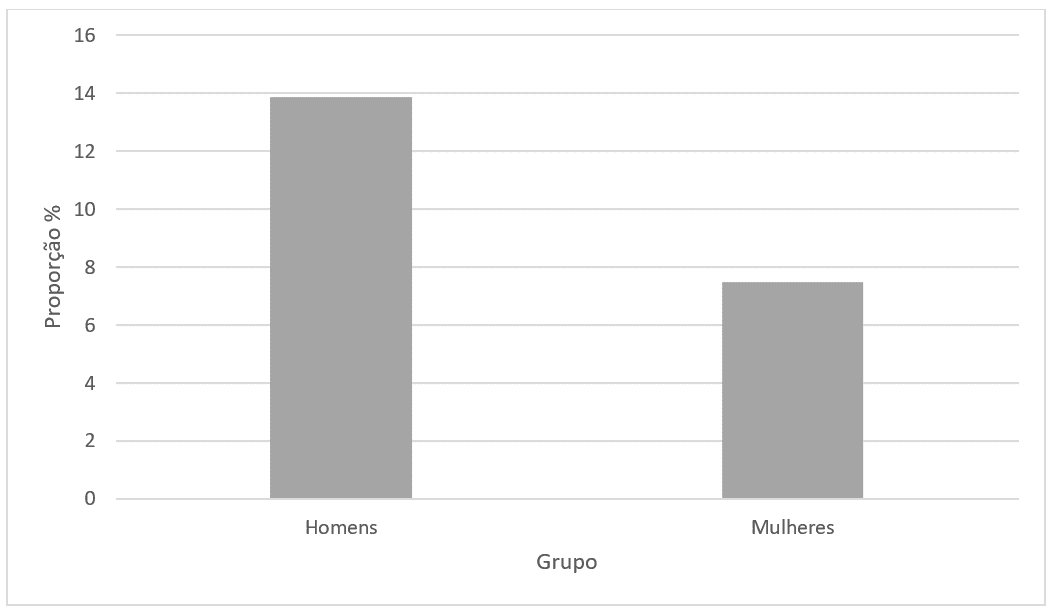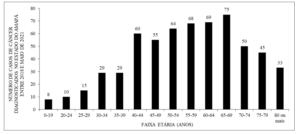REVIEW ARTICLE
FONSECA, Juliana Brito da [1], ROSSI, Karoline [2], VASCONCELOS, Suzana dos Santos [3], MOREIRA, Danilo José Silva [4], OLIVEIRA, Vinicius Faustino Lima de [5], DENDASCK, Carla Viana [6], DIAS, Claudio Alberto Gellis de Mattos [7], OLIVEIRA, Euzébio de [8], ARAÚJO, Maria Helena Mendonça de [9], FECURY, Amanda Alves [10]
FONSECA, Juliana Brito da et al. Gastric cancer in the northern region and its possible risk factors: a quantitative analysis of deaths from 2015 to 2019 in Brazil. Revista Científica Multidisciplinar Núcleo do Conhecimento. Volume 01, Issue 02, Year 09, pp. 05-17. February 2024. ISSN: 2448-0959, Access Link: https://www.nucleodoconhecimento.com.br/health/possible-risk-factors, DOI: 10.32749/nucleodoconhecimento.com.br/health/possible-risk-factors
ABSTRACT
Gastric cancer (GC) is gaining importance in Brazil due to the quantitative increase in the pathology in the population. The main risk factors evidenced by epidemiological studies are genetic and environmental factors, mainly the country’s characteristic diet, rich in foods high in sodium and starch. Additionally, the consumption of alcoholic beverages and smoking, as well as infection caused by the bacterium Helicobacter pylori, which is related to pathological processes of the stomach that can lead to the development of gastric GC, are highlighted. Thus, the present study concluded that the Northern region of Brazil is the most affected by this type of GC compared to other regions of the country, due to the predominance of risk factors in this locality and the high rates of stomach GC registered during the period analyzed by the present study.
Keywords: Medical Education, Stomach Neoplasms, Lifestyle.
1. INTODUCCIÓN
Gastric cancer (GC) is an aggressive pathology that is usually diagnosed in advanced stages due to its delayed onset of symptoms (Arco et al., 2021). It ranks fifth among the most common malignant tumors worldwide and third in terms of cancer mortality (Lozano et al., 2021).
According to the INCA (National Cancer Institute), it is the fourth most frequent malignant tumor in men and the sixth in women in Brazil – excluding non-melanoma skin cancer – with the incidence increasing from the fourth decade of life in both genders, thus exemplifying its importance, as this pathology occupies a high position in the prevalence ranking of cancer in the country (INCA, 2019; Zilberstein et al., 2013).
The development of GC is multifactorial, involving both genetic and environmental components. In the literature, the main environmental factors associated with the onset and progression of gastric cancer are: 1) dietary habits, such as excessive consumption of foods rich in salt and starch, pickled and poorly preserved foods, and a diet low in fresh fruits and vegetables; 2) lifestyle habits such as smoking and alcohol consumption; 3) gastric infection by the bacterium Helicobacter pylori (Zilberstein et al., 2013; Lozano et al., 2021).
A diet rich in salt and starch promotes the initial stages of chronic gastritis through atrophy of the gastric mucosa, promoting cell death and, consequently, regenerative proliferation of cells, which can lead to dysplasia. Moreover, these foods are rich in nitrates/nitrites and favor the formation of nitrosamines, which contribute to irritation of the gastric mucosa (Machlowska et al., 2020; Resende; Mattos; Koifman, 2006).
On the other hand, a diet rich in fruits and vegetables acts as a protective factor due to the presence of ascorbic acid and vitamin E, antioxidant agents that inhibit the production of these irritants of the stomach mucosa (Resende; Mattos; Koifman, 2006).
In recent years, a worldwide trend has been observed, including in Brazil, of a reduction in the incidence and mortality rates of GC. The factors attributed to this reduction are: improvement in food storage and hygiene, increased consumption of fresh fruits and vegetables, and a decrease in cases of Helicobacter pylori (Machlowska et al., 2020; Resende; Mattos; Koifman, 2006).
However, in the Northern region of Brazil, the opposite trend is observed, with continuous high rates of incidence and mortality from GC, which are linked to the risk factors that are more prevalent in this part of the country (Zilberstein et al., 2013).
2. OBJECTIVES
To quantitatively analyze deaths from gastric cancer from 2015 to 2019 with a focus on the Northern region of Brazil.
3. METHODOLOGY
The data was collected on the DATASUS website (http://datasus.saude.gov.br/), following these steps:
1) Access the link http://datasus.saude.gov.br/, select the “TABNET” icon, and then choose the “Vital Statistics” option. Then select “Cancer (INCA site)”. On this page, select “Cancer Mortality Atlas”.
2) On the next page, on the left side, several search options with Brazil map icons appeared. Click on the second option, which provides data on “Proportional distribution of total cancer deaths, by primary tumor location, by sex, location, for the selected period”.
3) After this step, select the period 2015-2019, the region, sex (all), Topography by type of cancer, and ICD C-16 Stomach. Repeat this process for all regions of Brazil.
4) Again, click on the option that provides data on “Proportional distribution of total cancer deaths, by primary tumor location, by sex, location, for the selected period”.
5) After this step, select the period 2015-2019, the Northern region, sex (male), Topography by type of cancer, and ICD C-16 Stomach. Then repeat the search, but this time select the female sex.
The estimates for stomach cancer for the year 2020 were collected through the following steps:
1) Access the link https://www.inca.gov.br/, on the left side, select “Cancer” under “Highlights”, then select “Cancer Numbers”.
2) In the tab that opens, below the text titled “Cancer Statistics”, click on “Access the estimate of new cases here”.
3) After this process, select the option “by State/Capital”, the Central-West region, and also choose the option “by Neoplasm (adjusted rate), stomach cancer”. Repeat this procedure for all other regions of the country.
From these available and collected data on the Ministry of Health – DATASUS and INCA website, up to the moment of this scientific work’s research, three thematic axes were selected. The first axis refers to the percentage of stomach cancer deaths in each region of Brazil, the second describes the estimates for the year 2020 of adjusted incidence rates per 100,000 inhabitants of stomach cancer, and the third relates the number of deaths from stomach cancer to sex in the Northern region of the country.
4. RESULTS
Different results were found for stomach cancer deaths among Brazilian regions, with the Northern region having the highest rate at approximately 10.86%, followed by the Northeast at 7.08%, Southeast at 6.41%, Central-West at 6.08%, and South at 5.98%.
A higher adjusted rate of new cases of stomach cancer per 100,000 inhabitants was observed in the Northern region, with 18.22 cases in males and 8.46 in females. The other regions reported the following rates: Central-West 9.49 cases in males and 5.95 in females, Northeast 11.37 cases in males and 6.12 in females, Southeast 8.81 cases in males and 3.27 in females, and South 11.78 cases in males and 5.06 in females.
In the Northern region of the country, 13.88% of stomach cancer deaths were reported in males and 7.47% in females. The data is presented in graphs 1, 2, and 3.
Graph 1 – Proportional distribution of total stomach cancer deaths, by primary tumor location, men and women, regions of Brazil, period 2015-2019

Graph 2 – Estimates for the year 2020 of adjusted incidence rates per 100,000 inhabitants of stomach cancer, by sex and primary tumor location, men and women, regions of Brazil

Graph 3 – Proportional distribution of total stomach cancer deaths, by primary tumor location, men and women in the Northern region, period 2015-2019

5. DISCUSSION
The Northern region of Brazil has the highest incidence and percentage of deaths from stomach cancer. This pathology is associated with lifestyle, environmental factors, socioeconomic factors, and nutritional factors, with the latter being one of the most important in development and relevant to explain the high numbers of incidence and deaths in the Northern region (Gonçalves et al., 2020; INCA, 2019; Silva and Felício, 2016).
5.1. NUTRITIONAL FACTORS
According to Gonçalves et al. (2020), diet is an important risk factor for the development of stomach malignancies. The risk of a diet high in salt, starch, and nitrates/nitrites, and low in fresh fruits and vegetables is highlighted.
Alcohol consumption also has a damaging effect on the gastric mucosa, which is due to the action of nitrosamines, components of alcoholic beverages, which damage the stomach mucosa and lead to the development of cancer (Ávila et al., 2019).
In the Northern Region, a high consumption of salt was observed, used in the preservation of meats and seafood – for example, jerked beef and salted shrimp. Salt irritates the gastric mucosa, favoring the process of gastric cancer development due to continuous aggression to this epithelium, promoting cell death and subsequent cell degeneration, which can lead to dysplasias (Machlowska et al., 2020; Resende; Mattos; Koifman, 2006).
Pickled and canned foods have high consumption rates in the Northern Region. Carcinogens present in these foods interact with the epithelial cells of the gastric mucosa, causing structural genetic mutations and changes in their expression (Machlowska et al., 2020).
According to Resende, Mattos, and Koifman (2006), the diet of the Northern population is characterized by the high consumption of cassava flour, present in various regional dishes. This flour usually contains aniline, a source of NH2 and NO2 radicals. These chemical substances, during digestion, undergo chemical processes leading to the formation of nitrosamines – significant carcinogens for the pathogenesis of stomach cancer, as they damage the genetic material of stomach cells, reducing the production of mucus (a protective factor of the gastric mucosa) and leading to the appearance of lesions (Gonçalves et al., 2020; Resende; Mattos; Koifman, 2006).
In addition, the low consumption of vegetables and legumes observed by Resende, Mattos, and Koifman (2006) leads to a relative decrease in antioxidants (such as ascorbic acid and vitamin E), which contributes to the formation of nitrosamines.
Furthermore, tucupi, an acidic sauce derived from cassava, widely used in daily gastronomy in the North, especially in the states of Pará and Amapá, damages the stomach epithelium, making it more susceptible to H. pylori infection and the development of pathologies such as gastric ulcers – risk factors for gastric neoplasms (Resende; Mattos; Koifman, 2006).
5.2. SOCIOECONOMIC FACTORS
According to Guimarães and Sales (2017), households in the Northern region have the lowest rate of water distribution with proper treatment. About 50% of Brazilian citizens use alternative systems for sewage collection, such as discharging into rivers, or do not have toilets, with the highest deficit in sewage treatment found in the Northern region.
Most populations with lower socioeconomic levels do not have adequate basic sanitation. When compared to populations with high socioeconomic levels, they have higher rates of stomach cancer incidence, as they are more exposed to risk factors for this pathology (Silva; Felício, 2016; Guimarães; Sales, 2017).
Among the risk factors for a population not having adequate water treatment is the higher possibility of infection by H. pylori. It is believed that this bacterium is associated with a higher probability of developing stomach cancer (Resende; Mattos; Koifman, 2006; Guimarães; Sales, 2017).
5.3. HELICOBACTER PYLORI
Helicobacter pylori is a gram-negative bacterium with hundreds of strains of Amerindian, European, African, Asian, and Maori descent, demonstrating its wide variability and the challenge it has become to treat patients affected by such microorganism (Costa, 2021).
H. pylori infection is intimately related to various pathologies, such as gastritis, ulcers, mucosa-associated lymphoid tissue (MALT) lymphoma, and gastric adenocarcinoma (Costa, 2021; OMGE, 2021).
The average prevalence of H. pylori infection in the country is about 71.2%, but it reaches 90% in the Northern region. H. pylori is related to the development of gastric cancer, which is due to the CagA gene, as high concentrations of anti-CagA protein antibodies lead to pro-inflammatory cytokine releases. Thus, H. pylori was considered a type I carcinogen by WHO in 1994 (Costa, 2021).
The mechanism leading to H. pylori-related gastric cancer is based on successive infections by the bacterium, leading to active chronic gastritis that causes atrophy of the gastric mucosa. In this way, these precancerous lesions of the mucosa can progress to the dysplasia stage and subsequently to gastric cancer (OMGE, 2021; Gonçalves et al., 2020).
The fact that some H. pylori-infected patients develop gastric cancer has been associated with some genotypes of the bacterium, such as the CagA+ and VacA/s1m1 genotypes. Therefore, it is believed that the genetic variability of H. pylori favors the appearance of neoplasia (Rosero et al., 2022).
Furthermore, the bacterium strains have become increasingly resistant to antibiotics, which makes their eradication in patients difficult and facilitates the process leading to the development of gastric cancer (Sharifi et al., 2017).
5.4. ENVIRONMENTAL FACTORS AND THEIR RELATIONSHIP WITH SEX IN THE NORTHERN REGION OF THE COUNTRY
The chart 3 demonstrates that the percentage of stomach cancer is higher in men than in women in the Northern region of Brazil. Chart 2 also reveals a higher estimated rate of stomach cancer development in the Northern region, being more prevalent in males. These stomach cancer percentages are believed to be associated with environmental factors, with alcohol and smoking standing out, as these factors are more prevalent in males in the Northern region (Machlowska et al., 2020; Guimarães; Sales, 2017).
Individuals who consume alcohol are 3 times more likely to develop stomach cancer compared to those who do not. This is believed to be related to irritation of the gastric mucosa caused by excessive alcohol consumption, i.e., the increase in alcohol acetaldehyde damages DNA, increasing the possibility of stomach cancer development (Gonçalves et al., 2020; Guimarães; Sales, 2017).
According to Figueiredo Júnior et al. (2019), tobacco increases the risk of stomach cancer, especially in those who use more than 20 cigarettes per day, with occasional smokers having a higher chance of developing stomach cancer compared to former smokers. Additionally, about 30% of patients who smoke die from stomach cancer (Gonçalves et al., 2020).
6. CONCLUSION
The results indicated that the high incidence and mortality rates of gastric cancer in the Northern region of Brazil, compared to other regions of the country, may be associated with the behavioral, environmental, and social factors of this population, which may predispose these individuals to these significant numbers.
Among the causes that predispose to the emergence and development of stomach malignancies, this work addressed lifestyle habits, socio-environmental, and nutritional factors. Among lifestyle habits, alcohol consumption and smoking stand out; among socio-environmental factors, H. pylori infection is the main antecedent. Lastly, in nutrition, risk factors are associated with excessive consumption of salt, starch, nitrates/nitrites, and preserved foods, this set of factors has a significant expression in the population of the Northern Region.
The relevance of the topic is noted, which requires greater focus on studies, mainly focused on prevention, since the main risk factors for stomach neoplasms are avoidable. Thus, it would be of great value for public policies aiming to educate the population on how to avoid the risk factors of the pathology to be implemented in the country, in addition to the inclusion of screening for this type of cancer, as already occurs with other types of cancer in the country, such as breast cancer, for example.
REFERENCES
ARCO, D. D. C. et al. Actualización en cáncer gástrico. Nuevas clasificaciones moleculares. Revista Española de Patología, v. 54, n 2, p. 102-113, jun. 2021.
ÁVILA, C. L. M. et al. Epidemiología de cáncer gástrico en el tercer nivel de atención en salud en Chiapas. Revista de gastroenterologia de México, v. 84, p. 310-316, set 2019.
COSTA, R. A. L. Helicobacter pylori e seus aspectos clínicos-epidemiológicos: uma revisão de literatura. Brazilian Journal of Development, v. 7, n. 2, p. 14420-14438, fev. 2021.
GONÇALVES, F. S. et al. Perfil clínico epidemiológico do câncer gástrico: revisão integrativa. Pubsaúde, 3, a041, 2020. DOI: 10.31533/pubsaude3.a041.
GUIMARÃES, A. V. S.; SALES, M. L. Fatores de risco no desenvolvimento de câncer gástrico: uma análise na população brasileira. Rev. Br. de Ciên. da V. v. 5, n. 1, 2017.
INCA. Estimativa 2020: incidência de câncer no Brasil. Rio de Janeiro: INCA, 2019.
FIGUEIREDO JÚNIOR, A. M. et al. Câncer gástrico e fatores de risco ambientais: As influências do regionalismo amazônico e a infecção pela Helicobacter pylori. Revista Eletrônica Acervo Saúde, v. 11, n. 13, p. e1115, 31 ago. 2019.
LOZANO, C. E. et al. Nutritional management of gastric câncer. Endocrinología, Diabetes y Nutrición, v. 68, n. 6, p. 428-438, jul 2021.
MACHLOWSKA, J. et al. Gastric cancer: epidemiology, risk factors, classification, genomic characteristics and treatment strategies. International journal of molecular sciences, v. 21, n. 11, 2020.
MINISTÉRIO DA SAÚDE. TabNet. DATASUS, 2022.
OMGE – Organização Mundial de Gastroenterologia. Diretrizes mundiais da Organización Mundial de Gastroenterologia Helicobacter pylori. Organização Mundial de Gastroenterologia, 2021. 33 p.
RESENDE, A. L. S.; MATTOS, I. E.; KOIFMAN, S. Dieta e câncer gástrico: aspectos históricos associados ao padrão de consumo alimentar no estado do Pará. Revista de Nutrição, v. 19, n. 4, p. 511-519, ago. 2006.
ROSERO, C. Y. H. et al. Helicobacter pylori genotypes associated with gastric cancer and dysplasia in Colombian patients. Revista de gastroenterologia de México, v. 87, p.181-187, jun 2022.
SHARIFI, R. et al. PUFA dietético aumenta a apoptose no estômago de pacientes com sintomas dispépticos e infectados com H. pylori. Lipidis, mai. 2017. DOI: 10.1007/s11745-017-4257-y.
SILVA, V. C. S.; FELÍCIO, D. C. Fatores de risco para o câncer gástrico em grupos de classe sócioeconômico baixa: revisão literária. Revista de Iniciação Científica da Universidade Vale do Rio Verde, Três Corações, v. 6, n. 1, p. 3-10, 2016.
ZILBERSTEIN, B. et al. Consenso brasileiro sobre câncer gástrico: diretrizes para o câncer gástrico no Brasil. ABCD. Arquivos Brasileiros de Cirurgia Digestiva, v. 26, n. 1, p. 2-6, mar. 2013.
NOTE
The authors used the artificial intelligence ChatGPT 3.5 to assist in spelling and grammar correction. However, all searches for content and assessment of article quality were done authentically.
[1] Medical student at the Federal University of Amapá (UNIFAP). ORCID: 0000-0002-4293-2821. Currículo Lattes: http://lattes.cnpq.br/2957457330917059.
[2] Medical student at the Federal University of Amapá (UNIFAP). ORCID: 0000-0003-4518-2920. Currículo Lattes: http://lattes.cnpq.br/8169447371427223.
[3] Medical student at the Federal University of Amapá (UNIFAP). ORCID: 0000-0003-4751-7712. Currículo Lattes: http://lattes.cnpq.br/6911069085442715.
[4] Medical student at the Federal University of Amapá (UNIFAP). ORCID: 0000-0001-5366-663X. Currículo Lattes: http://lattes.cnpq.br/1083418332031478.
[5] Medical student at the Federal University of Amapá (UNIFAP). ORCID: 0000-0002-3797-8200. Currículo Lattes: http://lattes.cnpq.br/9535921049442818.
[6] PhD in Psychology and Clinical Psychoanalysis. Currently pursuing a PhD in Communication and Semiotics at the Pontifical Catholic University of São Paulo (PUC/SP). Master’s degree in Science of Religion from the Mackenzie Presbyterian University. Master’s degree in Clinical Psychoanalysis. Bachelor’s degree in Biological Sciences. Bachelor’s degree in Theology. Has been working for over 15 years with Scientific Methodology (Research Method) in guiding scientific production of Master’s and PhD students. Specializes in Market Research and Health-related Research. ORCID: https://orcid.org/0000-0003-2952-4337. Lattes: https://lattes.cnpq.br/2008995647080248.
[7] Biologist, Ph.D. in Theory and Research of Behavior, Professor, and researcher at the Institute of Basic, Technical, and Technological Education of Amapá (IFAP), the Professional and Technological Education Postgraduate Program (PROFEPT IFAP), and the Biodiversity and Biotechnology Postgraduate Program of the BIONORTE Network (PPG-BIONORTE), Amapá campus. ORCID: 0000-0003-0840-6307. Currículo Lattes: https://lattes.cnpq.br/8303202339219096.
[8] Biologist, Ph.D. in Tropical Diseases, Professor, and researcher in the Physical Education course at the Federal University of Pará (UFPA). ORCID: 0000-0001-8059-5902. Currículo Lattes: https://lattes.cnpq.br/1807260041420782.
[9] PhD student in Health Care Sciences at the Federal Fluminense University (UFF). Master’s degree in Health Sciences from the Federal University of São Paulo (UNIFESP); Specialist in Family Health from the State University of Ceará, UECE, Brazil; Specialist in Occupational Medicine from the Gama Filho University, UGF, Brazil; Specialist in Workers’ Health and Human Ecology from the Oswaldo Cruz Foundation, FIOCRUZ, Brazil; Specialist in Internal Medicine from the Hospital dos Servidores do Estado do Pará; Medical degree from the State University of Pará (UEAP). ORCID: 0000-0002-7742-144X. Currículo Lattes: http://lattes.cnpq.br/8427706088023830.
[10] Biomedical scientist, Ph.D. in Tropical Diseases, Professor, and researcher in the Medicine program at the Macapá Campus, Federal University of Amapá (UNIFAP), and in the Postgraduate Program in Health Sciences (PPGCS UNIFAP), Vice President for Research and Postgraduate Studies (PROPESPG) at the Federal University of Amapá (UNIFAP). ORCID: 0000-0001-5128-8903. Currículo Lattes: https://lattes.cnpq.br/9314252766209613.
Material received: December 18, 2023.
Material approved by peers: January 16, 2024.
Edited material approved by authors: February 2, 2024.















